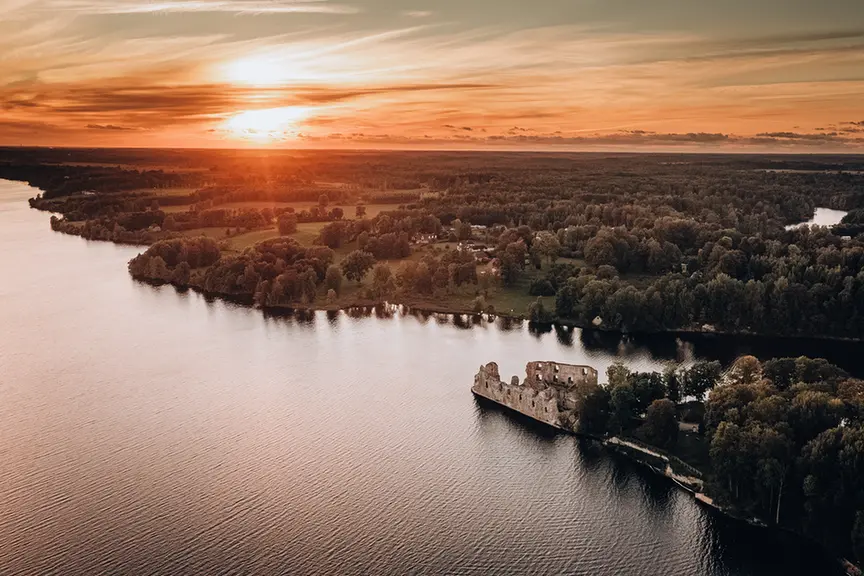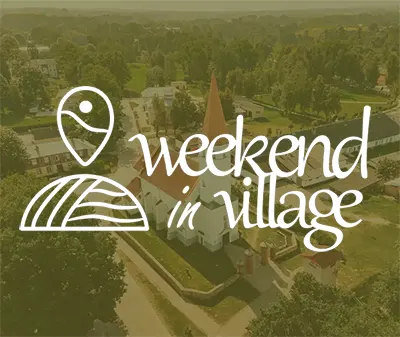
Daugavos ir Pērses slėnis prie Koknesės pilies griuvėsių
Kokneses parks, Koknese, Aizkraukles novads, Latvija, LV-5113In Koknese, the Daugava and the Pērse meet, and the confluence of these two rivers is proof of how the interaction between nature and humans shapes the landscape and tells a story of history. Standing by the former dry moat of the castle, the Pērse flowing on the right side and the Daugava a little farther to the left may appear as almost equal-sized rivers. Previous generations, standing here, saw completely different rivers – the mighty Daugava and the picturesque Pērse. The rivers flowed through a deep, scenic valley with sandstone outcrops, picturesque slopes, and rocks.When the Pļaviņas Reservoir was created in 1965, the water level rose by nearly 40 meters. The ruins of Koknese Castle, which once stood high on a hill, ended up right at the water’s edge. The cliffs, rapids, the Pērse waterfall, and the old river valley sank beneath the water. At this place, the Pērse was a small river that could be crossed by jumping over stones to reach the opposite – Bilstiņi – bank. The Pērse ravine was wider than the river itself, which meandered from one side of the ravine to the other. The riverbanks were rocky, a rushing stream flowed along them, and access to the river on both sides was possible only via separate paths. At the point where the Pērse flowed into the Daugava, it had formed a wide delta. It branched out into several channels shaped by spring floods. The sediments carried by the Pērse narrowed the Daugava at this place, creating small rapids.On the Riga–Daugavpils road, near the castle ruins, a bridge once spanned the Pērse. The wooden structure of the bridge, built on stone supports, was repeatedly washed away by spring floods and had to be rebuilt anew. From 1935 to 1965, a 40-meter-long and 7-meter-wide reinforced concrete bridge crossed the Pērse, resistant to floods. At that time, the Daugava flowed much farther from the castle ruins, leaving space for the mentioned road. Near the ruins stood the house called “Zvejnieki” (“The Fishermen”). It was built during manor times for the fisherman who supplied the estate with fish. Around the house grew large oak trees, planted to protect the buildings from spring ice drifts.Today, from this spot, we see the Daugava as a great river, but in the 1920s–1930s, when it could not be seen from here and flowed much lower, a ferry operated. Tourists used it to enjoy the beauty of the Daugava’s shores, crossing from one bank to the other. Nearby stood the Stūreslejas inn and other buildings. Before the flooding, all trees were cut down, the buildings demolished, the bridge blown up, and the former river valley was filled with the waters of the Pļaviņas Hydroelectric Power Station reservoir.
- Aizkraukle municipality and Koknese tourism information centre
1905. gada iela 7, Koknese
(+371) 29275412, (+371) 65161296 - Aizkraukle tourism information point
Lāčplēša iela 4, Aizkraukle
(+371) 25727419 - Jaunjelgava tourism information point
Jelgavas iela 33, Jaunjelgava
(+371) 27366222 - Plavinas tourism information point
Daugavas iela 49, Pļaviņas
(+371) 22000981 - Skrīveri Tourism Information Point
Daugavas iela 85, Skrīveri, Skrīveru pagasts
(+371) 25661983 - Staburags tourism information point
Staburaga saieta nams, 2. stāvs, Staburags, Staburaga pagasts
(+371) 29892925 - Nereta tourism information stand
Dzirnavu iela 5, Nereta, Neretas pagasts
(+371) 26674300 - Mazzalve tourism information
Skolas iela 1, Ērberģe, Mazzalves pagasts
(+371) 26156535 - Irsi manor barn - magazina
Irši, Iršu pagasts
(+371) 26344757










